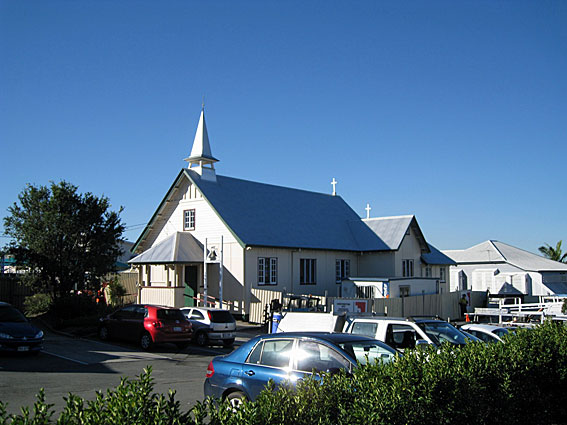
Anglican Church of the Ascension, Morningside
[Photograph by Geoffrey Cox, July 2012]

Anglican Church of the Ascension, Morningside
[Photograph by Geoffrey Cox, July 2012]
Historical and Technical Documentation by Geoffrey Cox
© OHTA 2012 (last updated July 2012)
This historic timber church was designed by architects Atkinson & Conrad, and built in 1924 as a War Memorial. It was dedicated by Archbishop Sharp on 25 January 1925.1
The organ that existed in this church between the mid 1960s and 1992 was essentially a rebuild of one built around 1930 by C.W. Leggo of Sydney for St Stephen's Anglican Church, Hurlston Park, NSW.2 The installation and rebuilding of the organ at Morningside was carried out between 1964-67 by Fr R.H. Miles, Rector of the parish at that time. The instrument was dismantled at Hurlston Park in April 1964. Part of it was in use at Morningside by Christmas 1964, although it was not completed until December 1967. The instrument was dedicated on the Sunday after Ascension, 1968.3
Leggo's organ at Hurlston Park was one of three that he built around 1930 using pipework from the 1888 Centennial International Exhibition organ built by George Fincham of Melbourne, installed in 1889 at the Masonic Hall, Melbourne and in 1905 in the Lyceum Hall, Sydney.4 It was a single-manual instrument with pedals, using tubular-pneumatic action. There were five ranks on the manual (including one divided stop) and two stops on the pedal.5
The organ was placed at Morningside on a platform over the west door of the church, with the console at the opposite end of the church, adjacent to the sanctuary. There was a mechanically operated swell pedal whose mechanism (balanced by an old boot) was quaintly visible beneath the church! Fr Miles distributed the stops over two manuals and pedals, and expanded the stop list by extending the Open Diapason/Principal rank (already extended by Leggo) to 2ft pitch on the Great Organ, but without adding a top octave of pipes. He also dulpexed it to the Pedal Organ. The soundboard, swell box, the keyboard and all of the pipework from Hurlston Park were retained, and a second keyboard and new action were added.
| GREAT Open Diapason Principal Fifteenth SWELL Stopped Diapason Bass Stopped Diapason Treble Salicional Hohl Flute PEDAL Bourdon Bass Flute Principal Fifteenth Octave COUPLERS Great to Pedal Swell to Pedal Swell to Great Swell Octave Swell Octave to Great |
8 4 2 8 8 8 4 16 8 8 4 2 |
A A A [or 4?] B B A A A |
[1967; without top octave] [replaced an earlier Oboe 16ft (Tenor C) at Hurlston Park] [1967] [1967] [1967] |
Balanced (mechanical) swell pedal
Detached console
Direct electric and electro-pneumatic action.6
The organ was advertised for sale in 1991,7 and broken up in 1992 by W.J. Simon Pierce. The pipework contributed to the enlargement of the organ at Christ Church Anglican Church, St Lucia by Simon Pierce in 1994.8
___________________________________________________________________________
1 Anglican Diocese of Brisbane, Records and Archives Centre, MORN S098, Box 5.
2 John Maidment, Gazetteer of New South Wales Pipe Organs (Melbourne: Society of Organists (Vic) Inc, 1981) gave the date as 1931, whereas Fr Miles gave it as 1929.
3 Personal communication to G. Cox from Fr. R.H. Miles, 1973.
4 Enid Matthews, Colonial Organs and Organbuilders (Carlton: Melbourne University Press, 1969), pp. 189, 215.
5 Maidment, op. cit.
6 Specification noted by G. Cox, 1973.
7 Organ Society of Queensland Newsletter, vol. 18, no 6 (June 1991), p. 28.
8 Ian McKinley, 'An Organ Transplant: A Brief History of the Organ at Christ Church, St Lucia,' The Organ Voice, vol. 21, no. 4 (Winter 1994), pp. 9-16.